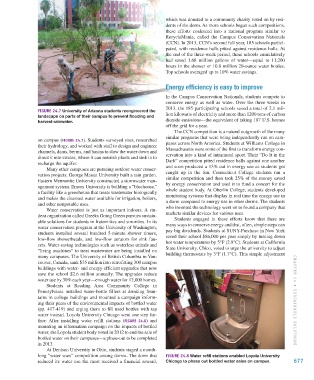Page 678 - Environment: The Science Behind the Stories
P. 678
which was donated to a community charity voted on by resi-
dents of the dorm. As more schools began such competitions,
these efforts coalesced into a national program similar to
RecycleMania, called the Campus Conservation Nationals
(CCN). In 2013, CCN’s second full year, 185 schools partici-
pated, with residence halls pitted against residence halls. At
the end of the three-week period, these schools cumulatively
had saved 1.68 million gallons of water—equal to 11,200
hours in the shower or 10.8 million 20-ounce water bottles.
Top schools averaged up to 10% water savings.
Energy efficiency is easy to improve
In the Campus Conservation Nationals, students compete to
conserve energy as well as water. Over the three weeks in
2013, the 185 participating schools saved a total of 2.1 mil-
Figure 24.7 University of Arizona students reengineered the
landscape on parts of their campus to prevent flooding and lion kilowatts of electricity and more than 1200 tons of carbon
harvest rainwater. dioxide emissions—the equivalent of taking 187 U.S. homes
off the grid for a year.
The CCN competition is a natural outgrowth of the many
similar programs that were being independently run on cam-
on campus (Figure 24.7). Students surveyed sites, researched puses across North America. Students at Williams College in
their hydrology, and worked with staff to design and engineer Massachusetts were some of the first to transform energy con-
channels, dams, berms, and basins to slow the water down and servation into a kind of intramural sport. Their “Do It in the
direct it into swales, where it can nourish plants and sink in to Dark” competition pitted residence halls against one another
recharge the aquifer. and soon produced a 13% cut in energy use as students got
Many other campuses are pursuing outdoor water conser-
vation projects. George Mason University built a rain garden. caught up in the fun. Connecticut College students ran a
similar competition and then took 25% of the money saved
Eastern Mennonite University constructed a stormwater man- by energy conservation and used it to fund a concert for the
agement system. Emory University is building a “bluehouse,” whole student body. At Oberlin College, students developed
a facility like a greenhouse that treats wastewater biologically monitoring systems that display in real time the energy use in
and makes the cleansed water available for irrigation, boilers, a dorm compared to energy use in other dorms. The students
and other nonpotable uses. who invented the technology went on to found a company that
Water conservation is just as important indoors. A stu-
dent organization called Greeks Going Green pursues sustain- markets similar devices for various uses.
Students engaged in these efforts know that there are
able solutions for students in fraternities and sororities. In its many ways to conserve energy and that, often, simple steps can
water conservation program at the University of Washington, pay big dividends. Students at SUNY-Purchase in New York
students installed several hundred 5-minute shower timers, saved their school $86,000 per year simply by turning down
low-flow showerheads, and low-flow aerators for sink fau- hot water temperatures by 5°F (2.8°C). Students at California
cets. Water-saving technologies such as waterless urinals and State University, Chico, voted to urge the university to adjust
“living machines” to treat wastewater are being installed on building thermostats by 3°F (1.7°C). This simple adjustment
many campuses. The University of British Columbia in Van-
couver, Canada, sank $35 million into retrofitting 300 campus
buildings with water- and energy-efficient upgrades that now
save the school $2.6 million annually. The upgrades reduce
water use by 30% each year—enough water for 12,000 homes.
Students at Reading Area Community College in
Pennsylvania installed water-bottle fillers at drinking foun-
tains in college buildings and mounted a campaign inform-
ing their peers of the environmental impacts of bottled water CHAPTER 24 • Su STA in A bl E Sol u T i on S
(pp. 417-419) and urging them to fill used bottles with tap
water instead. Loyola University Chicago went one step fur-
ther: After installing water refill stations (Figure 24.8) and
mounting an information campaign on the impacts of bottled
water, the Loyola student body voted in 2012 to end the sale of
bottled water on their campuses—a phase-out to be completed
in 2013.
At Denison University in Ohio, students staged a month-
long “water wars” competition among dorms. The dorm that Figure 24.8 Water refill stations enabled Loyola University
reduced its water use the most received a financial reward, Chicago to phase out bottled water sales on campus. 677
M24_WITH7428_05_SE_C24.indd 677 13/12/14 10:40 AM

